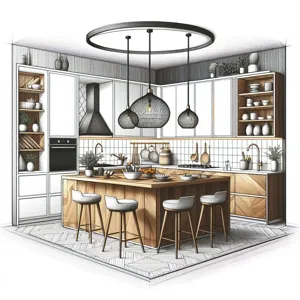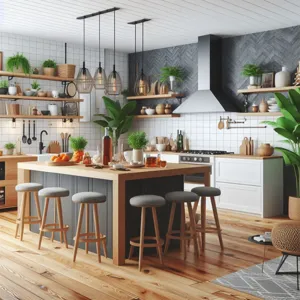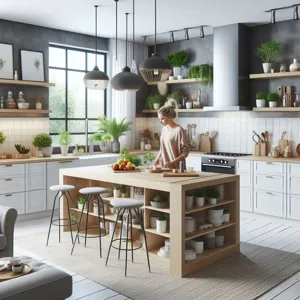Windows are more than just openings in our walls; they are gateways to light, fresh air, and views of the world outside.
However, the functionality and aesthetic appeal of these crucial elements of our homes largely depend on the window hardware we choose. From sleek modern designs to classic finishes, the right hardware not only enhances the beauty of your windows but also ensures their smooth operation and longevity. In this comprehensive guide, we will explore the diverse array of window hardware types available, delving into the unique features, benefits, and ideal applications of each option. Whether you’re renovating your home, building from scratch, or simply looking to upgrade your existing windows, our guide will unlock the possibilities that await you, making it easier than ever to find the perfect window hardware to complement your style and needs. Let’s dive in and discover how these often-overlooked details can transform your living space!
1. Introduction to Window Hardware

When it comes to the functionality and aesthetics of your windows, the right window hardware plays a pivotal role. Window hardware encompasses a variety of components, from the visible handles and locks that enhance security to the less noticeable hinges and brackets that ensure smooth operation. This essential hardware not only supports the mechanics of opening and closing windows but also contributes to the overall design and style of your home.
In this comprehensive guide, we will delve into the various types of window hardware available, exploring their specific functions, materials, and styles. Whether you’re renovating an old home, building a new one, or simply looking to upgrade your existing windows, understanding the different hardware options can unlock a world of possibilities for both form and function.
From classic casement window hinges to sleek sliding door tracks, each type of window hardware serves a unique purpose and can dramatically alter the way your windows perform and look. Additionally, with advancements in technology, modern window hardware also incorporates features that enhance energy efficiency and security, making it easier than ever to find the perfect match for your needs.
Join us as we embark on this journey through the myriad of window hardware types, helping you make informed choices that will elevate your living space and ensure the longevity and performance of your windows.
2. The Importance of Choosing the Right Window Hardware
Choosing the right window hardware is not merely an aesthetic decision; it’s a crucial aspect that impacts the functionality, security, and longevity of your windows. Whether you’re renovating a cherished historic home or installing new windows in a modern build, the hardware you select can significantly influence the overall performance of your window system.
First and foremost, the appropriate window hardware ensures smooth operation. From hinges to locks, every component has a specific role that contributes to the ease with which you can open, close, and secure your windows. For instance, high-quality hinges allow for effortless movement, preventing wear and tear that can result from subpar materials. Likewise, robust locks provide peace of mind, safeguarding your home against intruders while offering you the confidence that your windows are secure.
Beyond functionality, the right hardware also plays a vital role in energy efficiency. Properly fitted window hardware minimizes gaps that can lead to drafts, resulting in a more comfortable indoor environment and lower energy bills. For example, selecting suitable weather stripping can enhance insulation, creating a barrier that keeps your home warm in the winter and cool in the summer.
Aesthetic appeal is another essential factor. Window hardware comes in an array of designs, finishes, and styles, allowing you to complement your home’s decor while adding a touch of sophistication. Whether you prefer the classic charm of wrought iron or the sleek elegance of stainless steel, the right choice can elevate the overall look of your windows, enhancing curb appeal and adding value to your property.
Finally, durability cannot be overlooked. Investing in high-quality hardware means you’re choosing components that are built to withstand the elements and everyday use. Cheaper options might save you money upfront, but they often lead to increased maintenance costs and premature replacements. Opting for robust, reputable brands ensures that your window hardware will endure the test of time, providing you with a reliable solution for years to come.
In conclusion, when it comes to window hardware, making informed choices is paramount. Prioritizing functionality, energy efficiency, aesthetics, and durability will not only enhance your living space but also provide you with peace of mind. So, as you embark on your window hardware journey, take the time to explore the options available, and unlock the full potential of your windows.
3. Overview of Common Window Hardware Types

When it comes to window hardware, understanding the various types available can significantly enhance both the functionality and aesthetic appeal of your windows. Each type of hardware serves a specific purpose, allowing you to customize your window installations to suit your needs and style preferences. Here’s a closer look at some of the most common window hardware types you’ll encounter:
**1. Locks:** Window locks are essential for security and peace of mind. There are several types of locks, including cam locks, sash locks, and key-operated locks, each designed to secure different window styles. Cam locks, often used in sliding windows, are simple to operate and provide reliable security, while sash locks are commonly found in double-hung windows, ensuring both ease of use and safety.
**2. Hinges:** Hinges are crucial for operable windows, allowing them to open and close smoothly. Common types include butt hinges, which are typically used in casement windows, and pivot hinges, which allow the window to swing open from a central point. The choice of hinge can affect both the functionality and the overall look of your window, making it an important consideration in your selection process.
**3. Handles and Cranks:** For windows that open outward, such as casement or awning windows, handles and cranks are vital for operation. Crank handles provide the leverage needed to open the window with ease, while stylish handles can enhance the visual appeal of the window. Whether you prefer a modern lever-style handle or a classic, vintage-inspired design, there’s a handle to match every aesthetic.
**4. Stops and Hold-Open Devices:** These components are essential for controlling the opening of your windows. Window stops prevent the window from opening too far, protecting it from damage and keeping it secure. Hold-open devices, on the other hand, allow the window to remain open at a set angle, providing ventilation without the risk of slamming shut.
**5. Sash Rails and Stiles:** These structural components form the frame of the window and are essential for both functionality and durability. Sash rails are the horizontal pieces that hold the window panes, while stiles are the vertical supports. Together, they create a robust framework that ensures the window operates smoothly and maintains its integrity over time.
**6. Weatherstripping:** While often overlooked, weatherstripping is an essential component for energy efficiency. It helps to seal gaps around the window, preventing drafts and reducing heating and cooling costs. There are various types of weatherstripping materials available, including foam, felt, and vinyl, each offering different levels of insulation and durability.
By familiarizing yourself with these common window hardware types, you can make informed decisions that not only enhance the functionality of your windows but also add a touch of style to your home. Whether you’re renovating an existing space or installing new windows, the right hardware will unlock countless possibilities for your living environment.
4. Casement Window Hardware
Casement windows are celebrated for their ability to provide unobstructed views and optimal ventilation, and the hardware that supports these windows plays a crucial role in their functionality and aesthetic appeal. At the core of casement window hardware is the crank mechanism, which allows users to easily open and close the window with a simple turn of the handle. This design not only makes operation effortless, especially for larger windows, but also ensures a secure seal when closed, enhancing energy efficiency.
Typically crafted from durable materials such as stainless steel or brass, the crank handle and accompanying components are designed to withstand the rigors of daily use while resisting corrosion. A well-made crank system should operate smoothly, allowing the window to open outward at an angle, maximizing airflow without the obstruction of frames or sashes.
In addition to the crank mechanism, casement windows often incorporate a variety of hinges—usually side-mounted or top-mounted—that allow for smooth operation and stability. Depending on your style preferences, you can choose from different finishes, including polished, painted, or patinated options, which can complement both contemporary and traditional home designs.
Locking mechanisms are another essential aspect of casement window hardware, providing added security and peace of mind. Many modern casement windows feature multi-point locking systems that engage at multiple points along the frame, creating a tight seal that not only boosts security but also enhances energy efficiency by minimizing drafts.
When selecting casement window hardware, it’s important to consider both functionality and aesthetics. Choose hardware that aligns with your home’s architectural style and offers the durability needed for long-term use. By investing in quality casement window hardware, you can unlock the full potential of your windows—ensuring they are both beautiful and functional for years to come.
5. Double-Hung Window Hardware

Double-hung windows are a timeless choice in home design, seamlessly blending functionality with classic aesthetics. Characterized by two vertically sliding sashes, these windows allow for versatile ventilation options, making them a staple in both traditional and contemporary architecture. The hardware that supports double-hung windows plays a crucial role in ensuring their smooth operation and longevity.
At the heart of double-hung window hardware is the balance system, which can be either a spring or a block-and-tackle mechanism. This system allows for easy lifting of the sashes, enabling homeowners to open and close their windows effortlessly. When choosing hardware, it’s important to consider the material as well; options range from sturdy vinyl and aluminum to traditional wood. Each material not only contributes to the aesthetic appeal but also impacts the weight and ease of operation of the window.
Additionally, the locking mechanisms found in double-hung windows come in various designs, from simple cam locks to more advanced multi-point locks that enhance security. A well-designed lock not only keeps your home safe but also adds to the overall ease of use of the window.
Furthermore, the finish of the hardware can dramatically affect the look of your windows. Whether you prefer a sleek, modern finish or a more rustic, antique look, you’ll find a plethora of styles available, including bronze, chrome, and painted options. These finishes not only elevate the design of your windows but also enhance their resistance to the elements, ensuring durability over time.
Incorporating the right double-hung window hardware can elevate your home’s functionality while maintaining its visual appeal. By understanding the various components involved—from balances and locks to materials and finishes—you can make informed choices that enhance both the practicality and beauty of your windows. Embrace the elegance of double-hung windows, and explore the vast array of hardware options available to unlock their full potential in your home.
6. Sliding Window Hardware
Sliding windows are a popular choice for many homeowners, thanks to their sleek design and space-saving functionality. The hardware that facilitates their smooth operation is crucial to ensuring these windows not only look great but also function effectively and securely. When considering sliding window hardware, there are several key components to keep in mind.
At the heart of sliding window systems are the **track and roller mechanisms**. The track, typically made of aluminum or vinyl, is installed along the frame of the window, providing a smooth pathway for the window to glide open and closed. The rollers, located at the bottom of the window sash, are designed to fit snugly within this track, allowing for effortless movement. High-quality rollers are essential; they should be made from durable materials, such as nylon or stainless steel, to withstand wear and tear over time while remaining resistant to rust and corrosion.
Another important aspect of sliding window hardware is the **locking mechanism**. Safety is paramount, and modern sliding windows come equipped with various locking options, from simple hook locks to more advanced multi-point locking systems that engage at several points along the window frame. These features not only enhance security but also improve the overall energy efficiency of the window by ensuring a tight seal when closed, reducing drafts.
For those looking to customize their sliding windows, **handles and pulls** provide both functionality and aesthetic appeal. Available in a variety of finishes and styles, these hardware pieces can complement the interior and exterior décor of your home while making it easy to operate the window. Ergonomically designed handles ensure a comfortable grip, allowing for easy opening and closing, even for larger window sashes.
Lastly, consider the **weatherstripping** that accompanies sliding window hardware. It plays a crucial role in insulating and protecting your home from the elements. Quality weatherstripping helps block out rain, wind, and noise, contributing to a more comfortable living environment and reducing energy costs.
In summary, the right sliding window hardware is essential for combining style, functionality, and security. With a range of components available, homeowners can choose options that best fit their needs while enhancing the overall appeal of their living spaces. Whether you’re replacing existing windows or embarking on a new construction project, understanding the nuances of sliding window hardware will empower you to make informed decisions that unlock the possibilities of your home.
7. Awning Window Hardware

Awning windows are a popular choice for homeowners seeking a blend of functionality and style. Characterized by their unique design, these windows are hinged at the top and open outward, allowing for maximum ventilation while keeping rain and debris at bay. To achieve this seamless operation, it’s crucial to understand the specific hardware that makes awning windows effective and reliable.
At the heart of awning window hardware is the operator mechanism, which comes in various forms, including manual cranks and electric openers. The manual crank option is a popular choice for its simplicity and ease of use. With a gentle turn of the handle, the window effortlessly swings outward, inviting fresh air into the space. For those who prioritize convenience, electric operators offer the luxury of opening and closing windows at the touch of a button, which is particularly advantageous for hard-to-reach installations.
In addition to operators, awning windows rely on robust hinges and stay arms that ensure stability and security when the window is open. Heavy-duty hinges are essential for maintaining the window’s functionality over time, especially in areas with frequent wind or rain. Stay arms, on the other hand, hold the window securely in place, allowing homeowners to enjoy fresh air without the worry of sudden gusts.
Seals and weatherstripping are also critical components of awning window hardware. High-quality seals not only keep out drafts but also enhance energy efficiency by preventing air leakage. This is particularly important in climates with extreme temperatures, where maintaining a comfortable indoor environment is essential.
When selecting awning window hardware, it’s important to consider the materials used. Stainless steel and corrosion-resistant finishes are ideal for longevity, particularly in coastal areas where saltwater exposure can compromise hardware integrity. Choosing durable, high-quality components will ensure that your awning windows operate smoothly for years to come.
In summary, awning window hardware combines function and form to create a practical solution for ventilation and style in your home. By understanding the components involved and selecting the right hardware, homeowners can enhance both the aesthetic appeal and performance of their awning windows, unlocking a host of possibilities for natural light and fresh air.
8. Bay and Bow Window Hardware
When it comes to enhancing the elegance and functionality of bay and bow windows, the right hardware is essential. Bay and bow windows are popular architectural features that extend beyond the exterior of a home, allowing for a panoramic view and an influx of natural light. However, to make the most of their unique shape, you need specialized hardware that complements their design while ensuring ease of use.
Bay window hardware typically includes a combination of hinges, brackets, and rods that support the distinct angles of the window structure. These windows often feature multiple panels, and each requires a tailored approach to ensure smooth operation. Heavy-duty hinges are essential for sustaining the weight of the window sashes, while decorative brackets can enhance the visual appeal, adding a touch of sophistication.
On the other hand, bow windows, which consist of a series of adjoining windows that form a gentle curve, demand a more fluid approach. The hardware for bow windows often includes flexible tracks and custom-designed rods that allow the individual window sashes to open and close seamlessly. This setup not only facilitates ventilation but also maintains the aesthetic integrity of the curved design.
When selecting hardware for bay and bow windows, consider factors such as material and finish. Opt for durable materials like stainless steel or brass, which can withstand the test of time and resist corrosion. Finishes like oil-rubbed bronze or brushed nickel can complement your home’s overall décor while providing the necessary function.
Incorporating the right bay and bow window hardware can elevate your home’s style, offering a perfect blend of form and function. With the proper installation, these windows can become a stunning focal point that not only enhances your living space but also allows you to enjoy the beauty of the outdoors from the comfort of your home.
9. Specialty Window Hardware
When it comes to window hardware, specialty items play a crucial role in enhancing both functionality and aesthetics, especially for unique or custom window designs. Specialty window hardware encompasses a diverse range of fittings and accessories that cater to specific needs, preferences, or architectural styles.
For instance, consider the beauty and practicality of specialty hinges designed for casement windows. These hinges not only allow for smooth operation but also provide a secure hold when the window is open, maximizing ventilation while ensuring safety. Similarly, specialized locks and latches, often crafted from durable materials like stainless steel or brass, offer enhanced security features tailored for large picture windows or sliding glass doors.
Another fascinating aspect of specialty window hardware is the variety of finishes and designs available. Whether you’re aiming for a sleek modern look with minimalist handles or a vintage charm with ornate decorative brackets, the right hardware can significantly enhance the overall appeal of your windows. Many manufacturers offer customizable options, allowing homeowners and builders to select colors, styles, and materials that seamlessly integrate with their interior and exterior designs.
Moreover, specialty window hardware can also include energy-efficient components, such as thermal breaks in window frames and specialized weather stripping. These features not only improve comfort by regulating indoor temperatures but also contribute to energy savings, making them an intelligent choice for environmentally-conscious homeowners.
In summary, incorporating specialty window hardware can elevate your window installations, providing tailored solutions that combine practicality, security, and aesthetic appeal. Whether you’re renovating an older home or building a new one, exploring specialty options is a key step in unlocking the full potential of your windows.
10. Materials Used in Window Hardware
When it comes to window hardware, the materials used can significantly influence both the functionality and aesthetic appeal of your windows. Understanding the different types of materials available will help you make informed decisions that align with your style preferences and practical needs.
**1. Aluminum:** Lightweight yet incredibly durable, aluminum is a popular choice for window hardware. It is resistant to rust and corrosion, making it ideal for both indoor and outdoor applications. Aluminum hardware can be finished in a variety of colors, allowing for customization to match any decor. Its sleek, modern look complements contemporary designs beautifully.
**2. Stainless Steel:** Known for its strength and resistance to tarnishing, stainless steel is often used in high-end window hardware. This material not only provides a polished finish that exudes elegance, but it also offers exceptional durability against the elements. Stainless steel is particularly suited for coastal areas where saltwater exposure can be a concern.
**3. Brass:** With its warm, golden hue, brass hardware brings a classic, timeless quality to windows. This material is often chosen for its aesthetic appeal, particularly in traditional or vintage-style homes. While brass can tarnish over time, many homeowners appreciate the patina it develops, adding character to their window fixtures.
**4. Plastic (PVC):** For a budget-friendly option, plastic window hardware is lightweight and resistant to moisture, making it a practical choice for areas with high humidity. While it may lack the robust aesthetic qualities of metal options, modern advancements have led to plastic hardware that mimics the look of more expensive materials, making it a versatile choice.
**5. Wood:** Wooden hardware can add a touch of warmth and natural beauty to any window. Often used in traditional or rustic designs, wood offers a unique charm but requires more maintenance than metal or plastic options. It’s essential to treat wooden hardware with protective finishes to prevent warping or decay over time, especially in humid environments.
Each material offers distinct advantages and can dramatically alter the overall look and functionality of your windows. By carefully considering the materials used in your window hardware, you can enhance not only the durability and performance of your windows but also their visual impact within your living space. Whether you gravitate toward the sleek lines of aluminum or the classic touch of brass, the right choice can unlock a world of possibilities for your home.
11. Understanding Window Locks and Security Features
When it comes to window hardware, security is paramount. Understanding the various types of window locks and security features available can significantly enhance the safety of your home. Not only do these components protect against unauthorized entry, but they also contribute to your peace of mind, knowing that your loved ones and belongings are safe.
**Types of Window Locks**
There are several popular types of window locks that cater to different window styles. For example, **sash locks**, commonly found on double-hung windows, work by securing the upper and lower sashes together, preventing them from being opened from the outside. **Sliding window locks**, on the other hand, are designed for horizontal sliding windows, featuring a simple latch that secures the window in place. **Keyed locks** provide an additional level of security, allowing you to lock your windows with a key, making it impossible for anyone to open them without authorization.
**Additional Security Features**
Beyond basic locking mechanisms, modern window hardware often incorporates various security features that bolster your home’s defense. One such feature is the **reinforced frame**, which makes it more difficult for intruders to force windows open. **Window pins** provide extra protection for double-hung windows, while **burglar bars** or **grilles** can act as a deterrent against break-ins for those seeking a more visible security measure.
In addition to these physical locks and barriers, consider the benefits of **smart window locks**. These innovative systems allow you to control and monitor your windows remotely via a smartphone app. You’ll receive alerts if a window is opened unexpectedly, and you can even lock or unlock your windows from anywhere, adding a layer of convenience and security.
**Choosing the Right Lock for Your Needs**
When selecting window locks and security features, consider the specific needs of your home and the level of security you desire. Factors such as window type, location, and potential vulnerability should guide your decision-making process. By investing in high-quality window locks and security features, you’re not only protecting your property but also enhancing the overall value and safety of your home. Remember, windows are often the first point of entry for intruders, so ensuring they are equipped with effective security measures is a crucial step in safeguarding your living space.
12. Installation Tips for Different Window Hardware Types
When it comes to installing window hardware, the approach can vary significantly based on the type you choose. Understanding these nuances not only ensures a smooth installation process but also enhances the functionality and longevity of your windows. Here are some practical tips tailored for different window hardware types.
**1. Casement Window Hardware:**
For casement windows, which are hinged at the side and open outward, it’s crucial to ensure a proper alignment of the hinges. Before installation, double-check that the window frame is square. Use a level to confirm the alignment and make necessary adjustments. When attaching the hardware, start with the hinges, and ensure they are securely fastened to both the window and the frame to allow for smooth operation.
**2. Sliding Window Hardware:**
Sliding windows require a different approach. Start by installing the track first. Make sure it is level and securely fastened to the frame. When fitting the rollers to the sliding sash, ensure they are positioned correctly for a snug fit in the track. After installation, test the sliding action before finalizing the hardware placement to avoid any misalignment issues.
**3. Double-Hung Window Hardware:**
For double-hung windows, which feature two operable sashes, installation requires attention to detail. Begin with the lower sash by attaching the balance system according to the manufacturer’s instructions. Next, install the upper sash, ensuring both sashes can move freely within their tracks. It’s advisable to use a shim to keep the sashes equally spaced, which will help prevent wear over time.
**4. Awning Window Hardware:**
Awning windows, hinged at the top and opening outward, require careful consideration of the operator mechanism. Ensure that the operator arm is mounted securely and that the window opens and closes smoothly. Additionally, check the weather stripping during installation to ensure a tight seal when the window is closed, enhancing energy efficiency.
**5. Specialty Window Hardware:**
For specialty windows, such as those with custom shapes or designs, consulting the manufacturer’s installation guidelines is imperative. These windows may require unique hardware configurations, and following specific instructions will help avoid issues down the line.
In all cases, make sure to have the right tools on hand, including a level, drill, screwdriver, and measuring tape. Preparing your workspace by removing any debris and ensuring a clean environment will facilitate a smoother installation process. Finally, don’t forget to take your time—rushing can lead to mistakes that might compromise the window’s performance. By adhering to these tips for each window hardware type, you can confidently achieve a successful installation that enhances the beauty and functionality of your space.
13. Maintenance and Care for Window Hardware
Proper maintenance and care for window hardware is crucial to ensure the longevity and optimal performance of your windows. Just as you wouldn’t ignore the upkeep of your vehicle or home appliances, your window hardware deserves the same attention. Regular maintenance not only keeps your windows looking their best but also prevents costly repairs down the line.
Start with a simple cleaning routine. Dust and grime can accumulate on window hardware, leading to corrosion and malfunction. Use a soft cloth and a mild detergent to wipe down all visible surfaces, paying special attention to hinges, locks, and handles. For stubborn dirt, a gentle scrub with a soft-bristled brush can work wonders. Make sure to rinse thoroughly and dry the hardware to prevent moisture buildup.
Inspecting your window hardware periodically is equally important. Look for signs of wear, such as rust on metal components or cracks in plastic parts. If you notice any damage, address it immediately to prevent further deterioration. Lubricating moving parts is essential as well; a silicone-based lubricant can help keep hinges and locks functioning smoothly, reducing the likelihood of squeaks and jams.
Additionally, keep an eye on the weatherstripping around your windows. This vital component helps maintain energy efficiency by creating a seal that prevents drafts. If you notice it becoming brittle or damaged, it’s time to replace it. This not only enhances your windows’ performance but also keeps your living space comfortable year-round.
Finally, consider seasonal maintenance. As the weather changes, so do the needs of your window hardware. In the fall, check for any debris that may have accumulated in the tracks or frames, while in spring, make sure that everything is functioning smoothly after the winter months. By adopting a proactive approach to maintenance, you’ll ensure your window hardware remains reliable and aesthetically pleasing, enhancing both the functionality and beauty of your home.
14. Trends in Window Hardware Design
As we step into a new era of interior design, window hardware is no longer merely functional; it has become a focal point of aesthetic expression. Today’s trends in window hardware design reflect a blend of innovation, sustainability, and personalization, catering to a diverse range of styles and preferences.
One of the most prominent trends is the move towards minimalism. Sleek, streamlined designs with clean lines and unobtrusive finishes are gaining popularity. Hardware in matte black, brushed nickel, or even natural finishes is favored for its ability to blend seamlessly with modern decor, creating a sense of cohesion throughout the space. This minimalist approach not only enhances visual appeal but also emphasizes the beauty of the windows themselves.
Sustainability is another significant trend shaping window hardware design. Consumers are increasingly seeking eco-friendly options that minimize environmental impact. Manufacturers are responding by offering hardware made from recycled materials or sustainably sourced wood. Additionally, energy-efficient designs that facilitate better insulation and temperature control are becoming a priority, as homeowners look to reduce their carbon footprint while maintaining comfort.
Customization is also on the rise, with many brands offering bespoke solutions that allow customers to choose the color, finish, and even style of their window hardware. This trend towards personalization enables homeowners to create a unique look that reflects their individual tastes and enhances the overall design of their spaces. Whether it’s opting for ornate, vintage-inspired designs or contemporary geometric shapes, the possibilities are endless.
Lastly, technology is making waves in the realm of window hardware. Smart window systems that can be controlled via apps or home automation systems are becoming more accessible. These innovations not only offer convenience but also enhance security, allowing homeowners to monitor and manage their windows from anywhere.
In summary, the trends in window hardware design are as dynamic as they are diverse, driven by a need for functionality, sustainability, and personal expression. As you consider your options, think about how these emerging styles can not only complement your windows but also elevate the entire ambiance of your home.
15. Conclusion: Choosing the Right Hardware for Your Windows
In conclusion, selecting the right hardware for your windows is a critical decision that impacts both the functionality and aesthetic appeal of your home. With a myriad of options available, from traditional hinges and handles to modern locks and stays, it is essential to consider several factors to ensure you make the best choice for your specific needs.
Begin by evaluating the style of your home. Are you aiming for a classic look that complements historic architecture, or do you prefer a sleek, minimalist approach for a contemporary space? The right hardware should harmoniously blend with your decor while providing the necessary support and security for your windows.
Next, think about the practical aspects. Consider the type of windows you have—whether they are casement, sliding, or double-hung—as different hardware types are designed for specific window mechanisms. Additionally, assess the materials used in your windows; some hardware is better suited for wooden frames, while others work best with vinyl or aluminum.
Don’t forget to factor in safety and security. Investing in durable locks and sturdy hinges can prevent unwanted entry and enhance your peace of mind. Look for hardware that meets safety standards and offers reliability for years to come.
Finally, keep in mind your budget. While it can be tempting to splurge on high-end options, there are plenty of quality, cost-effective solutions that don’t compromise on design or functionality.
Ultimately, the right window hardware enhances your home’s beauty while providing the security and ease of use you desire. Take the time to research, compare options, and consult with professionals if necessary, ensuring that your final choice is one that you will be satisfied with for years to come. With the right hardware in place, your windows will not only perform their essential functions but also elevate the overall charm of your home.
As we wrap up our comprehensive guide to window hardware types, we hope you feel empowered to make informed decisions that enhance both the functionality and aesthetics of your windows. Understanding the diverse array of hardware options—from traditional hinges to modern locks and decorative finishes—opens up a world of possibilities for creating the perfect ambiance in your home. Whether you’re embarking on a renovation project or simply looking to upgrade your existing windows, the right hardware can make all the difference. We encourage you to explore these options further and consider how they fit into your design vision. Thank you for joining us on this journey to unlock the potential of your windows; we can’t wait to see how you transform your spaces!








